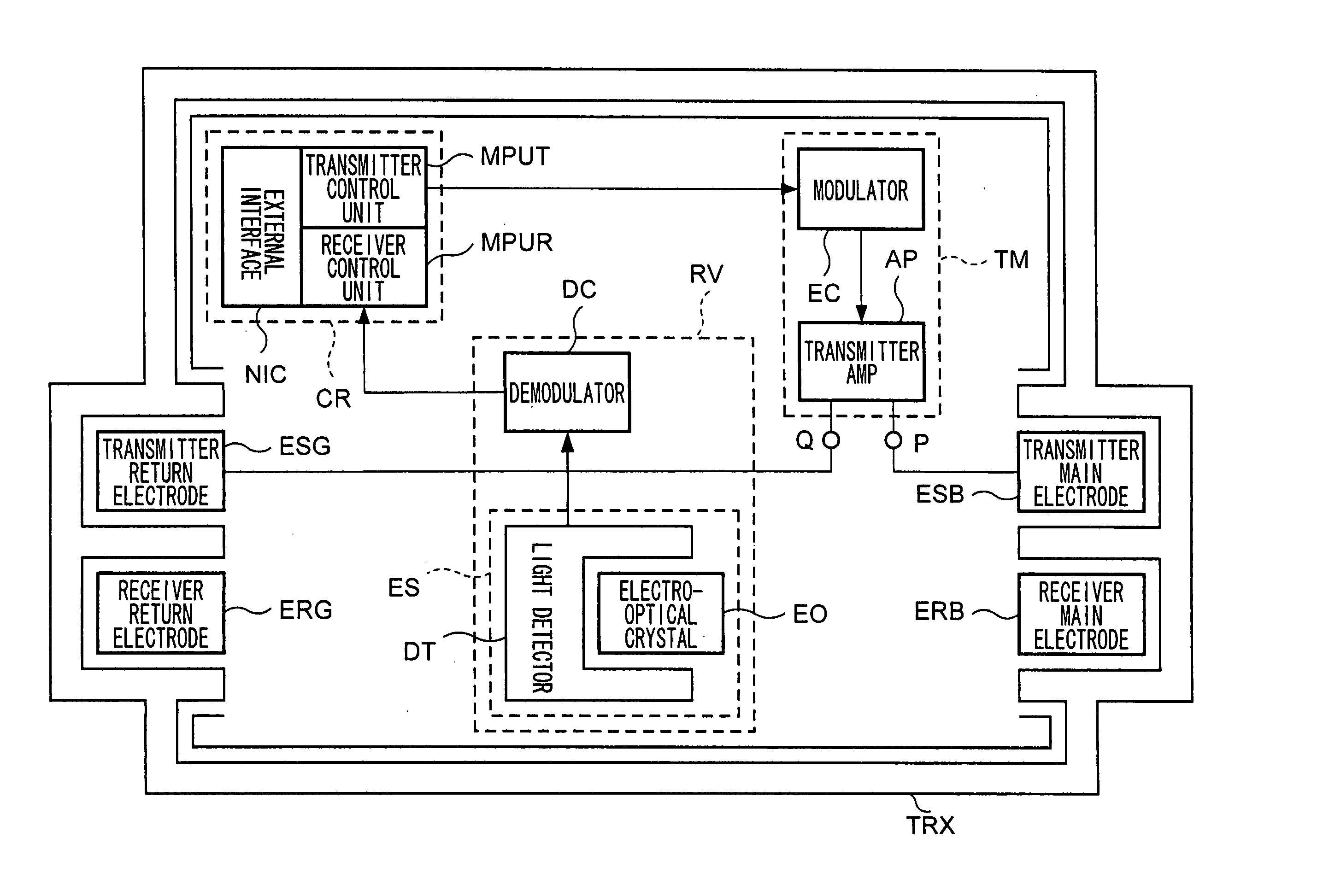Electric-field communication system, electric-field communication device, and electrode disposing method
a technology of electric field communication and electrode disposing, which is applied in the field of communication techniques, can solve the problems of establishing return paths, unable to maintain stable communication, and weakening of electrostatic coupling, and achieves the effect of sufficient communication distances
- Summary
- Abstract
- Description
- Claims
- Application Information
AI Technical Summary
Benefits of technology
Problems solved by technology
Method used
Image
Examples
first embodiment
A first embodiment will be described with reference to the drawings.
[0198]FIG. 1 shows an example of electric field communications apparatus TRX according to the present embodiment. As shown in FIG. 1, the electric field communications apparatus TRX is worn on human body HB. The electric field communications apparatus TRX can emit electric fields that vary in frequency from the tens of kHz to the multiples of MHz indicated for good conduction in the human body, and can detect electric fields that reach TRX through human body HB. Accordingly, several electric field communications apparatus TRX can perform communications through human body HB.
[0199] Electric field apparatus TRX can use a dielectric as a transmission medium, if the dielectric has conductivity through certain frequencies. Accordingly, electric field communications apparatus TRX can be placed in various locations, even outside the human body 1B, such as the walls, floors and ceilings of rooms. As well, electric field co...
example 1
LAYOUT EXAMPLE 1
[0250]FIG. 15 schematically shows the communications for layout example 1.
[0251] In FIG. 15, an example of communications between electric field communications apparatus TRX1 and TRX2 is shown.
[0252] First, transmitter control unit MPUT2 of electric field communications apparatus TRX2 converts into transmission signals the data to be sent to electric field communications apparatus TRX1. Then, transmitter control unit MPUT2 outputs the transmission signals to modulator EC2. Modulator EC2 modulates the carrier waves in response to the transmission signals. Then, modulator EC2 outputs the modulated signal to transmitter amplifier AP2. Transmitter amplifier AP2 amplifies the modulated signal and converts it into the voltage difference between terminal P2 and terminal Q2. Then, an electric field is radiated from transmitter main electrode ESB2 based on the voltage difference. The electric field reaches through human body HB locations where electric field communications ...
example 2
LAYOUT EXAMPLE 2
[0254]FIG. 16 schematically shows the communications for layout example 2. In FIG. 16, the communications between electric field communications apparatus TRX2a worn by user A and electric field communications apparatus TRX2b worn by user B, are illustrated.
[0255] First, the electric field modulated in response to the data to be transmitted is radiated from transmitter main electrode ERB2a of electric field communications apparatus TRX2a. For this situation, when the body of user A touches the body of user B, for example by a handshake, the electric field radiated in user A is transmitted to user B. Then, the electric field reaches electric field communications apparatus TRX2b. Then, electric field communications apparatus TRX2b acquires data sent by electric field communications apparatus TRX2a, and executes operations based on the data.
[0256] Moreover, concerning the operations of the process by which signals are radiated from electric field communications apparat...
PUM
 Login to View More
Login to View More Abstract
Description
Claims
Application Information
 Login to View More
Login to View More - R&D
- Intellectual Property
- Life Sciences
- Materials
- Tech Scout
- Unparalleled Data Quality
- Higher Quality Content
- 60% Fewer Hallucinations
Browse by: Latest US Patents, China's latest patents, Technical Efficacy Thesaurus, Application Domain, Technology Topic, Popular Technical Reports.
© 2025 PatSnap. All rights reserved.Legal|Privacy policy|Modern Slavery Act Transparency Statement|Sitemap|About US| Contact US: help@patsnap.com



